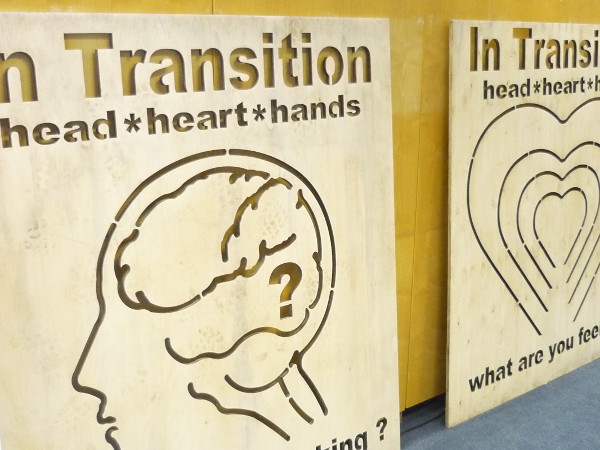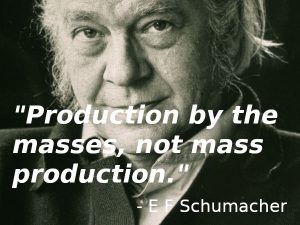Transition initiatives - introduction

“I’m not afraid of a world with less consumerism, less ‘stuff’ and no economic growth. I’m far more frightened of the opposite.” – Rob Hopkins
Contents
What are Transition initiatives?
They’re a great idea that’s come to life – community groups, run by local people, to build community resilience to mitigate the effects of peak oil and drastically reduce carbon emissions to mitigate the effects of climate change (note however that you don’t have to agree with the concepts of peak oil or climate change to understand the benefits that Transition Initiatives can bring, and join in anyway). They are based on four key assumptions:
- Life with dramatically lower energy consumption is inevitable, and it’s better to plan for it than to be taken by surprise.
- Our settlements and communities presently lack the resilience to enable them to weather the severe energy shocks that will accompany peak oil.
- We have to act collectively, and we have to act now.
- By unleashing the collective genius of those around us to creatively and proactively design our energy descent, we can build ways of living that are more sustainable.

Transition Bedford general meeting.
They start when a small group of motivated individuals in a community come together with a shared concern – how can our community respond to the challenges, and opportunities, of peak oil, climate change, and potential economic stagnation and food shortages? They recognise several important points:
- To a certain degree, we all experience life disconnected from the living environment, from our communities and from the land.
- Our profligate ways of living are depleting our energy resources to critical levels.
- We used immense amounts of creativity, ingenuity and adaptability on the way up the ‘energy slope’ (as we were starting to use up our oil reserves), and there’s no reason for us not to do the same on the ‘downslope’.
- We have to act now, rather than wait for governments or ‘someone else’.
- If we collectively plan and act early enough there’s a likelihood that we can create a way of living that’s significantly more connected, more vibrant and more in touch with our environment than the oil-addicted treadmill that we find ourselves on today.
Transitioners explain what Transition means to them.
The group then adopts the Transition Model and follows seven essential ingredients that will help develop and embed Transition within your community. (an explanation of the terms can be found here):
- Healthy groups
- Vision
- Community involvement
- Networks and partnerships
- Practical projects
- Part of a movement
- Reflect and celebrate

Fixing household goods at a Repair Café hosted by Transition Charlottesville in the US.
Transition Initiatives use the following processes to achieve the goal of increasing community resilience by reducing dependence on fossil fuels:
- Awareness-raising around peak oil, climate change and the need to undertake a community-led process to rebuild resilience and reduce carbon emissions
- Connecting with existing groups, including local government, in the community
- Forming groups to look at all the key areas of life (food, energy, transport, health, heart & soul, economics & livelihoods, etc.)
- Kicking off practical projects aimed at building people’s understanding of resilience and carbon issues and community engagement (such as community-supported agriculture, car clubs, local currencies, neighbourhood carbon reduction clubs, urban orchards, reskilling courses)
- Engaging in a community-wide visioning process to identify the future we want for ourselves rather than waiting for someone else to create a future that we won’t like
- Eventually launching a community-defined, community-implemented ‘Energy Descent Action Plan’. This enables the community to imagine how the future will be, and creates a co-ordinated range of projects in all these key areas, with the aim of bringing the community to a sufficiently resilient and low CO2-emitting state (a very small handful of Transition Initiatives have embarked on this phase so far)

Premiere of ‘Transition: the Movie’ in Totnes.
Background
Initially, the term used to describe the concept was ‘Transition Towns’, but this has been changed to ‘Transition’ followed by the name of the place (e.g. Transition Brixton), as there are now Transition cities, boroughs, valleys, peninsulas, postcodes, villages, hamlets and islands. The Transition concept emerged from the work done at Kinsale Further Education College in Ireland, led by permaculture designer Rob Hopkins, who, with his students, wrote an Energy Descent Action Plan. They designed a ‘road map’ to a sustainable future for their town, involving energy production, health, education, economy and agriculture. Then one of his students, Louise Rooney, developed the Transition Towns concept and presented it to Kinsale Town Council – resulting in the historic decision by councillors to adopt the plan and work towards energy independence.
In 2006, Rob adapted and expanded the idea in his hometown of Totnes in Devon. The idea spread quickly, and as of July 2010, there were over 500 communities with Transition Initiatives in the UK, Ireland, Canada, Australia, New Zealand, the US, Italy and Chile. Plus there are hundreds of places preparing to become Transition Initiatives.
We interview Jay Tompt of Transition Totnes about the REconomy project and Local Entrepreneur Forum events.
What are the benefits of Transition initiatives?
- Central to the Transition movement is the idea that life without oil could in fact be more enjoyable and fulfilling – ‘by shifting our mindset we can actually recognise the coming post-cheap oil era as an opportunity rather than a threat, and design the future low-carbon age to be thriving, resilient and abundant — somewhere much better to live than our current alienated consumer culture based on greed, war and the myth of perpetual growth.’
- The Transition process can increase a community’s resilience to environmental, economic or resource shocks.
- It’s a community-based movement that aims to reverse the trend of social breakdown by getting people interacting, and revitalising local economies.

Community gardens run by members of Transition Kinsale in Ireland, where the Transition movement was born.
- It’s a social experiment with no right and wrong answers – so anyone can get involved.
- It gives people the opportunity to do something in areas where governments and business are letting communities down.
- Transition Initiatives aim to be small-scale (ideally covering around 5000 people), so that communities can influence and relate to the area, and change is achievable.
- It’s an empowering, rewarding, life-changing movement that offers hope in tackling the inevitable challenges ahead.
- Children and adults are encouraged to learn new skills, as well as the skills that our grandparents had – so that we can grow our own food, repair and maintain equipment, generate our own energy, etc.
Rob Hopkins, founder of the Transition Movement, talks about the lack of imagination in modern society, and how to bring it back.
What can I do?
- Read about peak oil and climate change to make informed decisions on their importance.
- Read the Transition website or handbook for lots more on the Transition movement.
- Find out where your nearest Transition Initiative is and go along and meet them.
- If there isn’t one nearby, attend a two-day Training for Transition course, and think about starting one.
- Attend meetings, events, courses that your nearest Transition Initiative are running, and off you go!
The Transition Network have produced this Essential Guide to Transition, about how to start Transition in your community.

Transition Glastonbury street stall to recruit new members.
Specialist(s)
Thanks to Adam Herriott for information.


